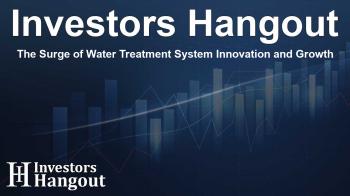The Surge of Water Treatment System Innovation and Growth

Introduction to the Water Treatment System Market Growth
As the world grapples with water scarcity and mounting pressure on water quality standards, the water treatment system market is experiencing remarkable growth. Notably, the market's value was pegged at USD 41.38 billion recently and is anticipated to soar to USD 73.06 billion by 2032, reflecting an impressive compound annual growth rate (CAGR) of 7.43% during the upcoming years.
Driving Forces for Market Expansion
This substantial growth is largely propelled by increasing concerns regarding water pollution and the consequent demand for clean drinking and industrial water. As both governmental bodies and private enterprises invest significantly in advanced purification technologies, a transformative shift is taking place. These investments have enabled various sectors—residential, commercial, and industrial—to adopt cutting-edge water treatment solutions to improve water quality and conserve this vital resource.
Regional Market Insights
In the U.S. alone, the water treatment system market has escalated from a valuation of USD 6.44 billion in previous years to an expected USD 12.07 billion by 2032, fostering a CAGR of 8.24%. This fast-paced growth can be attributed to escalating regulatory pressures aimed at managing water treatment and its environmental impact.
Key Players in the Industry
The landscape of the water treatment market is competitive and includes prominent players such as 3M, Honeywell International Inc., DuPont, and others. These companies have established reputations for delivering innovative solutions that address the burgeoning need for effective water purification and management.
Technological Advances Leading Change
One of the distinct trends in the market is the prevalence of reverse osmosis (RO) technology, which commands a substantial share of the revenue at over 28%. RO systems are favored for their ability to eliminate a wide range of contaminants, including heavy metals and pathogens, making them ideal for both civil and industrial applications. This convergence of effectiveness and user-friendliness has driven a marked increase in demand.
Growing Demand for Point-of-Use Installations
The point-of-use (POU) installation category has notably thrived, driven by heightened consumer awareness around water quality. Seeking clean water directly at the source, many households are now opting for compact POU systems that are easy to install and economically feasible. This trend is especially pronounced in urban areas where space is limited.
Emerging Markets and Regional Dynamics
The Asia Pacific region has captured the largest revenue share, around 35.28%, for water treatment systems, bolstered by rapid urbanization, industrialization, and population growth in countries such as China and India. As public awareness about water cleanliness increases due to contamination incidents, the urgency for advanced systems, including RO and filtration technologies, has intensified.
North America's Rapid Growth
North America stands out as a rapidly growing market, projected to expand at a CAGR of nearly 8.69% by 2032. This surge is driven by stricter regulations under the Safe Drinking Water Act, requiring higher standards for water purity. Moreover, there's considerable interest from utility companies in integrating IoT-driven solutions for monitoring and optimizing water treatment processes.
Conclusion
The water treatment system market faces a promising trajectory, stimulated by innovation and the need for sustainability. As we continue to navigate environmental challenges, advancements in water treatment technology will be pivotal in ensuring access to clean and safe water for both current and future generations.
Frequently Asked Questions
What is the projected market size for water treatment systems?
The water treatment system market is projected to reach USD 73.06 billion by 2032, growing steadily over the coming years.
Which technologies are driving the growth of the water treatment market?
Technologies such as reverse osmosis and point-of-use systems are key drivers, due to their efficiency in contaminant removal and growing consumer demand for clean water.
What regions are seeing the most growth in water treatment systems?
The Asia Pacific region leads in revenue share, with North America also showing significant growth due to regulatory demands and investments in technology.
Who are the key players in the water treatment system market?
Key players include 3M, Honeywell International Inc., DuPont, and several others that contribute to innovation and market dynamics.
What factors are influencing consumer interest in water treatment systems?
Increasing concerns about water quality, aging infrastructure, and health consciousness are driving demand for effective water treatment solutions in homes and businesses.
About The Author
Contact Henry Turner privately here. Or send an email with ATTN: Henry Turner as the subject to contact@investorshangout.com.
About Investors Hangout
Investors Hangout is a leading online stock forum for financial discussion and learning, offering a wide range of free tools and resources. It draws in traders of all levels, who exchange market knowledge, investigate trading tactics, and keep an eye on industry developments in real time. Featuring financial articles, stock message boards, quotes, charts, company profiles, and live news updates. Through cooperative learning and a wealth of informational resources, it helps users from novices creating their first portfolios to experts honing their techniques. Join Investors Hangout today: https://investorshangout.com/
The content of this article is based on factual, publicly available information and does not represent legal, financial, or investment advice. Investors Hangout does not offer financial advice, and the author is not a licensed financial advisor. Consult a qualified advisor before making any financial or investment decisions based on this article. This article should not be considered advice to purchase, sell, or hold any securities or other investments. If any of the material provided here is inaccurate, please contact us for corrections.

